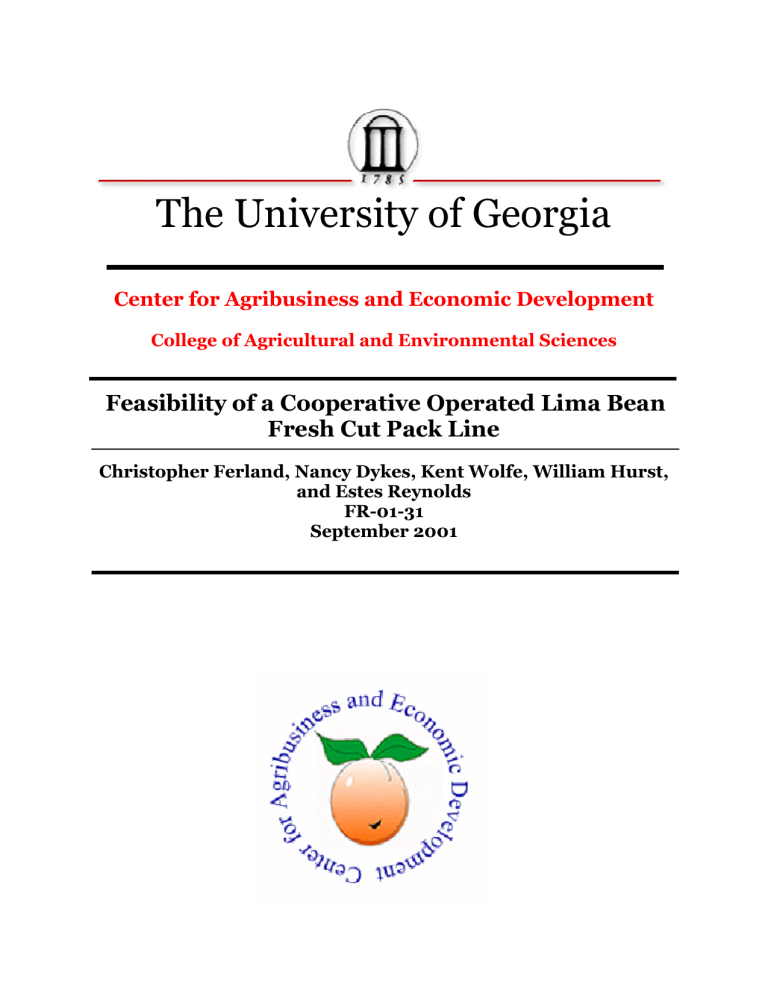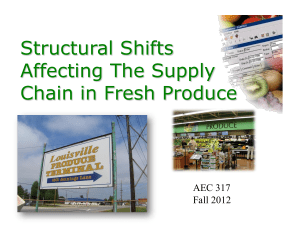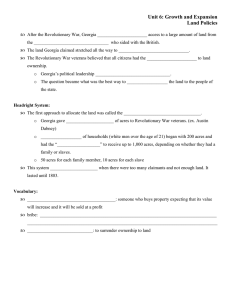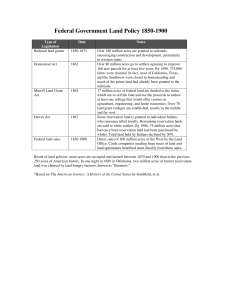The University of Georgia Feasibility of a Cooperative Operated Lima Bean

The University of Georgia
Center for Agribusiness and Economic Development
College of Agricultural and Environmental Sciences
Feasibility of a Cooperative Operated Lima Bean
Fresh Cut Pack Line
Christopher Ferland, Nancy Dykes, Kent Wolfe, William Hurst, and Estes Reynolds
FR-01-31
September 2001
Feasibility of a Cooperative Operated Lima Bean Fresh Pack Line
Introduction
This study is concerning the economic feasibility of a Lima (interchangeable with butter) bean fresh pack operation in Johnson, Laurens, Washington, Wilkinson, and
Treutlen counties. Success of the operation is dependent on a host of factors, including wholesale demands for the packaged product, quantity of product available from the field and type of packaging. Supply of a consistent quantity and quality affects the feasibility of operating a bean fresh pack line.
This study examines all the relevant economic issues surrounding the likely success of fresh packing beans in Georgia. A butter (lima) bean enterprise budget has been added to the report in order to evaluate the costs associated with the production of the beans. Currently, very few acres of lima beans are being grown in the 5 county area.
These counties have similar resources for planting vegetables. Growing vegetables in this region should be relatively easy. These counties have strong history in row cropping, providing them with farming experience. Center pivot irrigation remains in these counties and is under utilized. Certain vegetables can grow with center pivot watering depending on soil compaction or disruption of the droplets. Row crop prices have diminished the last five years and alternative crops need to be considered. Vegetable production would provide an opportunity to diversify the agricultural economy with a high value per acre commodity. This study begins with the potential market and finishes with the economic feasibility results.
Purpose
During the past few years, “value-added” has become a ‘buzz-word phrase’ for solving the problems of depressed agricultural income. Interest in the production of
"value-added" products from agricultural commodities has increased. Governor Zell
Miller even had an emphasis area for value-added farm products. Value-added products result when raw agricultural products are altered through processing or in other ways.
Cleaning and cooling, packaging, processing, and distributing can increase the value of farm products.
By processing their own raw, undifferentiated agricultural products into highervalue consumer-ready products, farmers have the opportunity to retain income. In addition, offering a higher return than a raw product, value-added products can open new markets, create recognition for a farm, and expand the market season.
A key point to remember is that adding value by processing food products increases safety risks. Therefore, rules and regulations are established by each state to protect the public health. In addition, the FDA regulates products going out of state, and the U.S. Food and Drug Administration enforces label ingredient legislation.
2
Fresh Pack Vegetable Market
Fresh packed vegetables can be found in most produce sections in grocery stores and local roadside stands. For the purpose of this study, the term fresh pack refers to a partially processed vegetable that has been packed to add value to the underlying commodity. Examples of fresh pack items usually seen in store are the corn cobs with the tips removed packed 2 to 4 on a Styrofoam plate with cellophane wrapping, potatoes that are packed on the Styrofoam, and hulled and bagged butter beans. All these items have been partially processed by either cutting off portions, hulling the shells, husking, or by packing a smaller more easily used portion.
Based on conversations with vegetable brokers and grocery store merchandisers, the vegetable markets are quickly approaching a fresh pack intensive market. Many brokers/merchandisers have stated they would prefer to receive certain vegetables that have been fresh packed to save on their labor costs and disposal fees. When the producer creates a product more easily moved and pushed into the market a premium can be requested for the product.
Vegetable consumption has increased over the past 15 years. A major portion of this increased consumption came from the fresh vegetable market. Parts of this increase can be attributed to increased shelf life by technological advances in cooling and storing, but also from marketing techniques. Fresh packing vegetables assist in this marketing section along with health advertisements increasing awareness to the general public on the benefits of eating fresh vegetables. The graph of below “Vegetable Per Capita Use,” shows that each category is showing some upward trend. From 1985-86 to 1999-2000, fresh vegetable consumption was up 31 percent to 165 pounds.
Vegetable Per Capita Use
(Actual and Trend)
180
160
140
120
100
80
60
40
20
0
Fresh
Frozen
Canning
1985 1986 1987 1988 1989 1990 1991 1992 1993
Years
1994 1995 1996 1997 1998 1999 2000f
The supply of fresh packed vegetables is a highly competitive venture with few companies involved in the process. In Georgia, the apparent competition packs on a
3 contract system with large commercial grocery stores. One package manager stated
“there is no such thing as a contract, these people will leave you today for a better price.”
Understanding this, the producer needs to deliver a consistent product in terms of quality and quantity to maintain buyers and markets.
Vegetable Production
Agriculture in Georgia is changing and many farmers have begun to grow more vegetables. Based on conversations with wholesalers in the Atlanta Farmer’s Market, demand in the vegetable market has grown faster than the supply. Many wholesalers talked about the need to import vegetables from out of state. This slight deficit in vegetables from Georgia opens a window for Georgia farmers to increase acreage. Each time fresh market acreage increases the frozen market also gains supply.
The five county region discussed in this study needs to examine which vegetables can be most economically grown, packed and sold in their area before jumping into vegetable production. This study will assist in part of this analysis but without historical production data a complete picture cannot be constructed.
Vegetable production in Georgia is a $635 million dollar industry. As the population of Georgia increases, the demand for fresh vegetables increases. This creates a situation where traditional vegetable growing counties do not have the resources to expand at the level needed to meet demand. This generates an opportunity for the five county region to enter the market with limited fear of competition from expansion in current areas. However, many of these areas have successful row crops, peanuts, and forage enterprises. If the prices of those commodities decrease low enough to make additional vegetable acreage appear economically viable, competition may increase.
The vegetables chosen for production in the five county region are butter beans, okra, sweet potatoes, field peas, eggplant and green peppers. These vegetables were selected for multiple reasons, the soil condition in the area, the market potential, and relative ease for production with center pivot irrigation versus trickle. Certain vegetables cannot use center pivot due to the water droplets stirring up soil borne disease on the plants or root disruption.
Butter Bean Fresh Pack Line Feasibility
This section will explore the components necessary for operating a butter bean fresh pack line. Four different acreage scenarios were investigated for this feasibility study, 150, 250, 300, and 400. Equipment included in this feasibility includes the shellers, baggers, butter bean pickers, cooler, and dump vats. The Pixall Company provided quotes for all the picking equipment. For now, the most cost effective picker for harvesting is a 4 row pull behind Pixall BH 100. These are one-row pickers and will require multiple tractors in order to achieve the best results in a timely fashion.
However, is acreage increases substantially or the cooperative has adequate funding, a four row Pixall Big Jack Picker was recommended for harvesting. The cost figures
4 below will be separated into only two packing lines based off the four acreage estimates, the low end acreage and the high end acreage. All components supplied can be used for other beans and peas. There was no relevant difference in shelf life if the products were atmospherically packed or just fresh packed and cooled. Cost data and other numbers were supplied by various private groups and the University of Georgia’s Department of
Agriculture and Applied Economics. Prior to any decisions about starting a butter bean packing line a breakeven analysis needs to occur. This allows for a profit/loss margin to be determined.
Equipment Costs
Equipment cost figures came from various food service processing units, The
Pixall Company, Newtec Inc, Ilapak and Noland Steel. The mandatory pieces of equipment include dump trailers; a complete cleaning and shelling system; tow behind and if needed self propelled pickers; and automated weigher, bagger, and sealer. This equipment provides a complete set up to finished packed fresh cleaned butter beans. The total price of the equipment is $189,900 adding 7% sales tax of $13,293 the grand total becomes $203,293, this includes a 4 row behind picker. The total cost including sale tax for an operation utilizing a self propelled 4 row pickers on 400 acres is $572,129.
Fixed Costs
Fixed costs associated with this packing line include the depreciation on the building, equipment, and interest on the investment funds. The projected fixed costs for the tow behind packing line is $123,525 or approximately $.67 per pound of finished product. The fixed cost for the packing using the self-propelled picker is $209,725 or
$.42 per pound.
Direct Costs
The figure for the direct costs represents a payment to the producer for the butter beans uncleaned and in the shell. An estimated price of $8.00 per bushel was used for delivery. This price came from various farmers whom deliver to shelling units.
Direct Labor
Labor cost calculations include the salaried and hourly labor to run the fresh pack line. The labor figures are automatically adjusted with an increase in pounds. The regular hours of operation are 8 hours per day, for 25 weeks of the season. The wages for the laborers are calculated at $6.00 per hour for 25 weeks of fulltime (8 hour days). The cooperative manager/salesperson receives an annual salary of $35,000 with the potential of commissions. This person is responsible for scheduling delivery of the butter beans to the plant and the market, ordering input supplies, and creating contacts for direct sales.
The manager will be the only employee to receive benefits, estimated at $8,750. A parttime bookkeeper, with an estimated salary of $7500, will be hired to assist the manager.
The total labor cost for the 150 acres operation is $144,300 or $.78 per pound of finished
5 product the figure for the 400 acre operations is $204,300 or $.41 per cleaned pound. If the operation decides to run a custom vegetable packing line additional labor figures will need to be calculated.
Variable Costs/ Other Direct Costs
Variable costs associated with this project include labor, utilities, insurance, repairs, rental agreements, disposal, and operating costs. Operating costs include: boxes, cleaning supplies, and bags. All of this will change depending on the pounds of product packaged. Positive relationships exist among the pounds processed and the variable costs. The total for the 150-acre scenario is $50,677 or $.27 per finished pound the cost and for 400 acres is $57,638 or $.12 per pound. The difference may be greater after the operation is running. The utilities and water were not adjusted dramatically between the different size operations and this may account for some of the noticeable prices. The bags price ranges were minor for each bag only costs $0.18, some distributors mentioned bulk bags purchasing, lowering the prices down to under $0.05 per bag, but then storage for these bags needs to be considered.
Income
Estimated income can be derived by multiplying the estimated pounds of butter beans placed into bags by the sales price per bag. The packaged price per pound was given to the researcher by the different firms presently packing butter beans as the average sales price though the season. The estimated yield is 125 bushels per acre, which converts to 30 pounds per bushel. A shrink reduction figure of 66.7% was used from the shelled product to the final product of cleaned beans. This shrinkage is due to the removal of the shell and cleaning, usually the typical yield is 33% of the total weight. So, the 30 pound bushel yields approximately 10 pounds of beans. Take these figures and multiply by the number of acres to receive each scenario’s total production of cleaned beans and multiply by the sales price of $2.00 a pound for the income. The 150-acre scenario produces 185,625 cleaned pounds of beans and an income of $371,250. The 400 acres scenario produces 495,000 cleaned pounds and an income of $990,000.
Total Cost & Profit/Loss
Adding the variable and fixed costs together gives the total cost of operating the fresh pack butter bean line for 25 weeks. The total cost of operating a shed to package
185,625 pounds of cleaned product (150 acres) is $468,502. The 400 acres of 495,000 pounds cleaned beans yields a total cost of $871,663. In order for the 150-acres scenario to break even, the packing shed operation needs to sell 29,281 bags but the line is only capable of bagging 23,203, producing a loss of $97,252.00. The breakeven number of bags for the 400 acres is 54,479, which is covered by the 61,875 bags actually capable of being produced for a profit of $118,338. The 400-acres scenario earns approximately
$.25 per pound cleaned and bagged. The operating efficiency for both operations appears low for an agricultural-based product. This can be attributed to the low number of acres used, high equipment cost, and conservative figures used by the researchers.
6
Butter Bean Fresh Pack Line Profit/Loss Analysis
Profit versus Budgeted Cost
Assuming the figures used in the economic feasibility section accurately reflect the actual cost of operating a fresh pack line, the profitability (or lack of) for the different acreage scenarios will be shown on the following charts.
Budget figures include operating expenses (utilities, taxes, labor, supplies), fixed costs (interest on start up cost, deprecation) and income from sales of cleaned and packed beans. Then the costs are subtracted from income resulting in the remaining profit or loss.
The next graphs show the relationship between budgeted cost and profit. The cost estimates are increased or decreased incrementally at 5% intervals to see the effect on profitability and risk.
Chart 1.
Profit versus % Budgeted Cost, 150 acres
Profit Versus Percent Change in Budgeted Costs, 150 acres
$0
($20,000)
($40,000)
($60,000)
($80,000)
($100,000)
($120,000)
($140,000)
($160,000)
($180,000)
85%
($26,976)
90%
($50,401)
95%
($73,826)
100%
($97,252)
105% 110%
($120,677)
115%
($144,102)
($167,527)
Percent Change
7
Chart 2.
Profit versus % Budgeted Cost, 200 acres
Profit Versus Percent Change in Budgeted Costs
$200,000
$165,581
$150,000
$131,645
$97,708
$100,000
$63,772
$50,000
$0
85% 90% 95% 100%
$29,835
105%
($4,101)
110% 115%
($38,037)
($50,000)
Percent Change
Chart 3.
Profit versus % Budgeted Cost, 300 acres
Profit Versus Percent Change in Budgeted Costs
$200,000
$150,000
$100,000
$50,000
$0
($50,000)
($100,000)
85%
$145,054
90%
$109,910
95%
$74,766
$39,622
100%
$4,478
105% 110%
($30,666)
115%
($65,810)
Percent Change
8
Chart 4.
Profit versus % Budgeted Cost, 400 acres
Profit Versus Percent Change in Budgeted Costs
$300,000
$249,087
$250,000
$205,504
$200,000
$161,921
$150,000
$118,338
$100,000
$74,754
$50,000
$0
85% 90% 95% 100% 105%
$31,171
110%
($12,412)
115%
($50,000)
Percent Change
At first glance, the differences in the cost between the 200 and 300 acres scenarios may appear odd. However, this is due to the extra cost for an additional picker and labor.
Each scenario is using different numbers of pickers and laborers.
Profit Versus Over/Under Estimated Sales Price
This section shows how the changes in the sales price of partially processed packed beans affects the profitability of the operation. The obvious result is as prices received decrease, profits decrease. The next graph shows at what point the sales price decreases enough to make the plant a risky (unprofitable) investment.
9
Chart 5.
Profit Versus Change in Sales Price, 150 acres
Profit Versus Change in Sales Price, 150 acres
($45,000)
($65,000)
($85,000)
($105,000)
($125,000)
($145,000)
($165,000)
($185,000)
($205,000)
($60,127)
($78,689)
($97,252)
($115,814)
($134,377)
$17.60
$16.80
$16.00
$15.20
$14.40
Sales Price
Chart 6.
Profit Versus Change in Sales Price, 200 Acres
Profit Versus Change in Sales Price, 200 acres
($152,939)
$13.60
$12.80
($171,502)
($190,064)
$12.00
$150,000
$100,000
$50,000
$0
($50,000)
($100,000)
($150,000)
$138,022
$100,897
$17.60
$16.80
$63,772
$16.00
$26,647
$15.20
$14.40
Sales Price
($10,478)
($47,603)
$13.60
($84,728)
$12.80
($121,853)
$12.00
10
Chart 7.
Profit Versus Change in Sales Price, 300 acres
Profit Versus Change in Sales Price, 300 acres
$150,000
$100,000
$50,000
$0
($50,000)
($100,000)
($150,000)
($200,000)
$113,872
$76,747
$39,622
$2,497
($34,628)
$17.60
$16.80
$16.00
$15.20
$14.40
Sales Price
Chart 8.
Profit Versus Change in Sales Price, 400 acres
Profit Versus Change in Sales Price, 400 acres
($71,753)
$13.60
$12.80
($108,878)
($146,003)
$12.00
$250,000
$217,338
$200,000
$167,838
$150,000
$118,338
$100,000
$68,838
$50,000
$19,338
$0
($30,163)
($50,000)
($79,663)
($100,000)
($129,163)
($150,000)
$17.60
$16.80
$16.00
$15.20
$14.40
Sales Price
$13.60
$12.80
$12.00
As one can see the 200 and the 400 acre scenarios appear to be more economically feasible than the 150 and 300 according to the cost and profitability among the scenarios.
11
Financing, Operating, and Ownership Arrangements for a Butter Bean Fresh Pack
Line
Presently only one financing and ownership method is being considered for the packing line in the five county region of Georgia; a marketing cooperative. The main purposes of this packing line are: to provide the local producers an alternative means of producing income, diversify agricultural products grown, and capture a portion of the farm to retail price spread.
Cooperatives
A special type of producer cooperative called a “New Generation Cooperative
(NGC)” or a “closed cooperative,” combines a solution to both financing and operating questions. Producers would an initial portion of the fresh pack line equipment and working capital cost through stock or options on stock sales. Each share of stock would provide the right and obligation to market 1 bushel of butter beans through the packing line. The remaining capital could be raised through debt financing. Operation of the processing line could remain under the control of the producer/owner through the cooperative. Unclean beans could be priced to the producer through various arrangements including profit sharing of the final product. Any funds generated through an assessment per pound marketed through the packing shed would be used to retire debt and would increase the producer’s equity in the operation.
The recommended organizational structure would be a fresh pack butter bean line cooperative formed as a value-added processing, closed cooperative of defined or selected membership, whereby members invest through the purchase of shares of stock.
These shares serve as a dual contract. Each producer has both the obligation and the right to deliver to the cooperative. Likewise, the cooperative is obligated to accept delivery, given that quality standards are met. These delivery rights and obligations are transferable. Each member is still granted only one vote regardless of the number of shares owned.
The basic concept of this new type of cooperative is that producers capture profits that occur beyond the farm-gate, owning and controlling the local businesses that are positioned to earn those profits. The motivation of new generation cooperatives is more offensive than defensive–take control of your own destiny and be proactive rather than reactive. The main emphasis in cooperatives of this type has been on value-added processing, niche marketing, and producer/members viewing themselves as producing a finished food product rather than a raw commodity.
Producers tend to take greater interest in operations developed as a producer cooperative since they are also investors. The typical amount of member equity required is 50-60% of the initial equity needed for the project. This gives potential lenders the security of sufficient producer commitment. Banks primarily serving cooperatives have been the primary institutions in financing the remaining 40-50% of capital needed by new cooperatives. Many commercial banks are also funding cooperatives. The USDA also
12 has numerous financial programs that can assist cooperatives that meet certain criteria.
Credit unions and the Farm Credit System have also actively lent funds to farmers to invest in new cooperatives. Other helpful support systems in the development of these new cooperatives include communities, regional economic development commissions, individual rural electric cooperatives, and university extension services.
New Generation Cooperatives retain many principles of traditional cooperatives such as democratic control through a one member, one vote policy; excess earnings are distributed among members as patronage refunds or dividends, and the board of directors is elected from the membership by the membership. The financing of NGCs allows for all, or almost all, net earnings to be returned to members at year-end since the members invest capital up-front. Future expansion is financed in the same way as original equity: members invest through the purchase of shares. In some instances, preferred shares may be offered to the community or general public. This allows communities to support the project while keeping control in the hands of the members. Some of the advantages of the New Generation Cooperatives include the ability of producers to react quickly to opportunities, the collective response of members to problems or opportunities, the creation of wealth within a community and local ownership keeps it there, stability for producers and efficiency for the packing shed through the restricted membership, consideration of the interests of the community through a diverse set of stakeholders, and commitment to the quality of the product by both the producers and processor.
One of the keys to success of a New Generation Cooperative is producer commitment. The group of producers must be motivated, determined and committed.
Other keys to success include public policy that supports cooperative formation, financial institutions willing to finance the cooperative, and consultant or facilitators to help producer groups through the aspects of the process. These keys to success seem to be evident in Georgia. Georgia produce growers must take ownership of the concept and drive the investigation into the possibility of operating a functional value added packing shed in Georgia.
In order to determine the number of shares needed to finance this project, one takes the total cost divided by the total number of estimated units needed for a standard operating year. This will yield a share price for 100% financing by the producers. If the producers wish to the lower their amount of equity the share prices will drop accordingly to the amount financed outside the operation.
Share Price
The next chart shows the estimated share price at various producer financing scenarios, 100%, 75%, 60%, 50%, and 40%. Remember, one share is equal to one bushel of beans.
Chart 9. Share prices at various financing options, 150 acres.
Share Price at Differnt Prodcuer Financing Levels, 150 Acres
$30.87
$32.00
$30.00
$28.00
$26.00
$24.00
$22.00
$20.00
$18.00
$16.00
$14.00
$12.00
$10.00
$8.00
$6.00
$4.00
$23.16
$18.52
$15.44
100% 75% 60%
Percent Prodcuer Financed
50% 40%
$12.35
Chart 10. Share prices at various financing options, 200 acres.
Share Price at Different Producer Financing Levels, 200 acres
$19.65
$20.00
$18.00
$16.00
$14.00
$12.00
$10.00
$8.00
$6.00
$4.00
$14.74
$11.79
$9.82
100% 75% 60%
Percent Prodcuer Financed
50% 40%
$7.86
13
14
Chart 11. Share prices at various financing options, 300 acres.
Share Price at Different Producer Financing Levels, 300 acres
$20.38
$22.00
$20.00
$18.00
$16.00
$14.00
$12.00
$10.00
$8.00
$6.00
$4.00
$15.29
$12.23
$10.19
$8.15
100% 75% 60%
Percent Prodcuer Financed
50% 40%
Chart 12. Share prices at various financing options, 400 acres.
Share Price at Different Producer Financing Levels, 400 acres
$19.53
$20.00
$18.00
$16.00
$14.00
$12.00
$10.00
$8.00
$6.00
$4.00
$14.65
$11.72
$9.77
$7.81
100% 75% 60%
Percent Prodcuer Financed
50% 40%
Another option for financing the plant is to contact the local development authorities and submit grant requests to them and the state. Often the development authorities will assist in part of the grant writing or organizing of application material to be submitted to larger state funds. Currently, Georgia is taking submission for funds through the GeorgiaOne Authority.
15
Return Per Share
Each share shall receive a portion of the profits. These dividends or profit sharing will occur either quarterly or annually based upon the recommendation of the cooperative’s Board of Directors. The following charts show returns per share for only the economically feasible lines, 200 and 400 acre scenarios. If custom vegetable work or other products are produced the returns will need to be recalculated.
Chart 13.
Returns Per Share at Various Sales Prices, 200 acres.
Returns Per Share By Sales Price, 200 acres
$5.00
$4.00
$3.00
$2.00
$1.00
$-
$(1.00)
$(2.00)
$(3.00)
$(4.00)
$3.68
$17.60
$2.69
$16.80
$1.70
$16.00
$0.71
$15.20
$14.40
Sales Price
$(0.28)
$(1.27)
$13.60
$(2.26)
$12.80
$(3.25)
$12.00
16
Chart 14.
Returns Per Share at Various Sales Prices, 400 acres.
Returns Per Share By Sales Price
$5.00
$4.00
$3.00
$2.00
$1.00
$-
$(1.00)
$(2.00)
$(3.00)
$4.35
$17.60
$3.36
$16.80
$2.37
$16.00
$1.38
$15.20
$14.40
Sales Price
$0.39
$(0.60)
$13.60
$(1.59)
$12.80
$(2.58)
$12.00
The Center for Agribusiness
& Economic Development
The Center for Agribusiness and Economic Development is a unit of the College of
Agricultural and Environmental Sciences of the University of Georgia, combining the missions of research and extension. The Center has among its objectives:
To provide feasibility and other short term studies for current or potential Georgia agribusiness firms and/or emerging food and fiber industries.
To provide agricultural, natural resource, and demographic data for private and public decision makers.
To find out more, visit our Web site at: http://www.caed.uga.edu
Or contact:
John McKissick, Director
Center for Agribusiness and Economic Development
Lumpkin House
The University of Georgia
Athens, Georgia 30602-7509
Phone (706)542-0760 caed@agecon.uga.edu
The University of Georgia and Fort Valley State University, and the U.S. Department of
Agriculture and counties of the state cooperating. The Cooperative Extension Service offers educational programs, assistance and materials to all people without regard to race, color, national origin, age, sex or disability.
An equal opportunity/affirmative action organization committed to a diverse work force.
FR-01-31 September 2001
Issued in furtherance of Cooperation Extension Acts of May 8 and June 30, 1914, the
University of Georgia College of Agricultural and Environmental Sciences, and the U.S.
Department of Agriculture cooperating.
J. Scott Angle, Dean and Director





